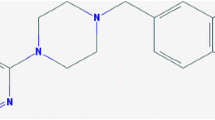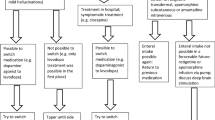Abstract
Dopamine agonists have been widely used as add-on to levodopa in the treatment of Parkinson’s disease with motor fluctuations. However, the use of dopamine agonists in early Parkinson’s disease and levodopa-naive patients is controversial. Although dopamine agonists have been compared with levodopa, no studies exist which directly compare one dopamine agonist with another. This evidence-based review compares the results of large published studies of early treatment of Parkinson’s disease with dopamine agonists (cabergoline, ropinirole or pramipexole) with similar studies using levodopa.
Because of their design, the common variables analysed in all studies were the proportion of patients who developed dyskinesia, those withdrawn from the trial and the mean change from baseline in Unified Parkinson’s Disease Rating Scale (UPDRS) parts II and III scores.
Cabergoline, pramipexole and ropinirole were similarly effective in reducing the risk for dyskinesia relative to levodopa (p < 0.01 for all three). The reduction in risk for dyskinesia was slightly more evident for pramipexole and ropinirole (p < 0.0001) than cabergoline (p = 0.0074). Odds ratios (95% confidence intervals [CI]) relative to levodopa were 0.38 (0.19–0.78) for cabergoline, 0.25 (0.13–0.47) for pramipexole and 0.31 (0.18-0.53) for ropinirole. The absolute risk reductions (95% CI) were, respectively, 8% (2.2–13.7), 20% (11.7–29.8) and 25% (13.6–36.7), ropinirole reducing the risk significantly more than cabergoline. The mean change from baseline UPDRS was similar for pramipexole and ropinirole (not evaluated for cabergoline). The proportion of withdrawn patients and the adverse effect profiles of the three agonists were similar to each other, with the exception of oedema, which was less prominent for ropinirole than for the other two agonists.
Cabergoline, pramipexole and ropinirole are comparable choices for the delay of dyskinesia. Their adverse effect profiles are also similar, but they are less well tolerated than levodopa. The motor antiparkinsonian benefit of dopamine agonists is somewhat smaller than that of levodopa.




Similar content being viewed by others
References
Olanow CW, Watts R, Koller WC. An algorithm (decision tree) for the management of Parkinson’s disease: treatment guidelines. Neurology 2001; 56Suppl. 5: S1–S88
Shrag A, Quinn N. Dyskinesias and motor fluctuations in Parkinson’s disease: a community-based study. Brain 2000; 123: 2297–305
Rascol O, Goetz C, Koller W, et al. Treatment interventions for Parkinson’s disease: an evidence based assessment. Lancet 2002; 359: 1589–98
Ramaker C, Van Hilten JJ. Bromocriptine versus levodopa in early Parkinson’s disease. Available in The Cochrane Library [database on disk and CD ROM]. Updated quarterly. The Cochrane Collaboration; issue 3; Oxford: Update Software, 2000: CD002258
Parkinson’s Disease Research Group in the United Kingdom. Comparisons of therapeutic effects of levodopa, levodopa and selegiline, and bromocriptine in patients with early, mild Parkinson’s disease: three year interim report. BMJ 1993; 307: 469–72
Rinne UK, Bracco F, Chouza C, et al. Early treatment of Parkinson’s disease with cabergoline delays the onset of motor complications. Drugs 1998; 55, Suppl. 1: 23–30
Hundemer HP, Lledo A, Van Laar T, et al. The safety of pergolide monotherapy in early-stage Parkinson’s disease: one-year interim analysis of a 3-year double-blind, randomized study of pergolide versus levodopa [abstract]. Mov Disord 2000; 15Suppl. 3: 115
Lledo A, Hundemer HP, Van Laar T, et al. Long term efficacy of pergolide monotherapy in early-stage Parkinson’s disease (PD): one-year interim analysis of a 3-year double-blind, randomized study of pergolide versus levodopa [abstract]. Mov Disord 2000; 15Suppl. 3: 126
Parkinson Study Group. Pramipexole vs levodopa as initial treatment for Parkinson’s disease. JAMA 2000; 284: 1931–8
Rascol O, Brooks DJ, Korczyn AD, et al. A five-year study of the incidence of dyskinesia in patients with early Parkinson’s disease who were treated with ropinirole or levodopa. N Engl J Med 2000; 342: 1484–91
Albin RL, Frey KA. Initial agonist treatment of Parkinson disease. Neurology 2003; 60: 390–4
Chase T, Baronti F, Fabbrini G, et al. Rationale for continuous dopaminomimetic therapy of Parkinson’s disease. Neurology 1989; 114: 1429–40
Ahlskog JE, Muenter MD. Frequency of levodopa-related dyskinesias and motor fluctuations as estimated from the cumulative literature. Mov Disord 2001; 16: 448–58
Parkinson Study Group. Dopamine transporter brain imaging to ascertain the effects of pramipexole vs levodopa on Parkinson disease progression. JAMA 2002; 287: 1653–61
Whone AL, Remy P, Davis MR, et al. The REAL-PET study: slower progression in early Parkinson’s disease treated with ropinirole compared with 1-dopa. Neurology 2002; 8: A82–3
Ahlskog JE. Slowing Parkinson’s disease progression: recent dopamine agonist trials. Neurology 2003; 60: 381–9
Fahn S, Elton R. Unified Parkinson’s disease Rating Scale Development Committee. Unified Parkinson’s disease Rating Scale. In: Fahn S, Marsden CD, Calne D, editors. Recent developments in Parkinson’s disease. New York: MacMillan, 1987: 153–63
Schechtman E. Odds ratio, relative risk, absolute risk reduction, and the number needed to treat: which one should we use?Value Health 2002; 5: 431–6
Hedges LV, Olkin I. Statistical methods for meta-analysis. California: Academic Press Inc, 1985
Agresti A. Categorical data analysis. New York: Wiley, 1990
Song F, Altman DG, Glenny A-M, et al. Validity of indirect comparison for estimating efficacy of competing interventions: empirical evidence from published meta-analyses. BMJ 2003; 326: 472–6
Inzelberg R, Carasso RL, Schechtman E, et al. A comparison of dopamine agonists and catechol-O-methyltransferase inhibitors in Parkinson’s disease. Clin Neuropharmacol 2000; 23: 262–6
Rascol O. Ropinirole as compared with levodopa in Parkinson’s disease [letter]. N Engl J Med 2000; 343: 885
Shenker N, Gentleman JF. On judging the significance of differences by examining the overlap between confidence intervals. Am Stat 2001; 55: 182–6
Miyasaki JM, Martin W, Suchowersky O, et al. Practice parameter: initiation of treatment for Parkinson’s disease: an evidence-based review. Neurology 2002; 58: 11–7
Acknowledgements
No sources of funding were used to assist in the preparation of this manuscript. The authors have no conflicts of interest that are directly relevant to the content of this manuscript.
Author information
Authors and Affiliations
Corresponding author
Rights and permissions
About this article
Cite this article
Inzelberg, R., Schechtman, E. & Nisipeanu, P. Cabergoline, Pramipexole and Ropinirole Used as Monotherapy in Early Parkinson’s Disease. Drugs Aging 20, 847–855 (2003). https://doi.org/10.2165/00002512-200320110-00006
Published:
Issue Date:
DOI: https://doi.org/10.2165/00002512-200320110-00006




